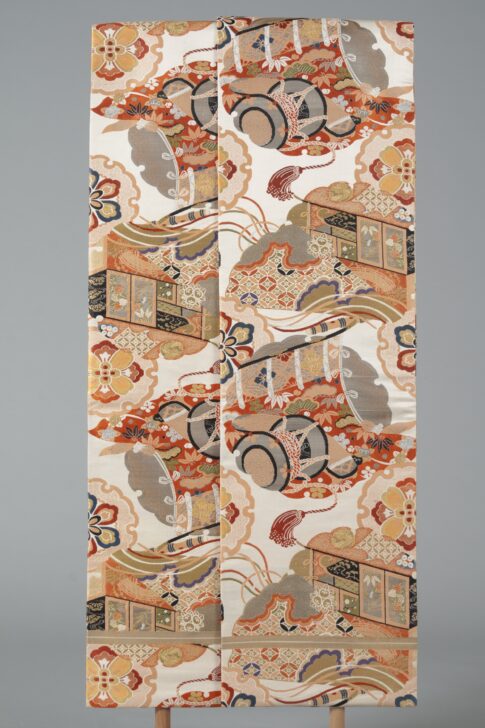Obi
Japanese

Description
Obi
Japan, Showa period (1926–1989)
1960s–70s
Silk with woven designs
Gift of Howard and Patricia Yamaguchi, 2013/2.373
These gorgeous obi, all made of brocade, were intended to be worn with and complement formal kimono for festive events such as weddings and New Year’s gatherings. Some are designed with motifs, shapes, and colors that have auspicious meaning. For example, the green obi with the gold hexagonal shapes refers to eternity (evergreen) and longevity (the hexagon is a traditional symbol of a tortoise shell). Others have classic motifs, such as the off-white obi with drums and ox carts based on the Tale of Genji, an eleventh-century novella.
These obi were made in the Nishijin area of the city of Kyoto, which has dominated the production of high-quality woven textiles since the fifteenth century. The weaving industry flourished there under the protection and encouragement of the flamboyant military rulers of the Azuchi-Momoyama period (1568–1615), Oda Nobunaga (1534–1582) and Toyotomi Hideyoshi (1536–1598). The production of Nishijin textiles is very complex, and specialized in five main areas—designing and creating patterns, producing silk threads, producing tools (including weaving machines), weaving, and final sewing—each accomplished in a different workshop.
Subject Matter:
This is a Nishiji, Nishiki, and Maru Obi in Zentsuu gara
Motifs include large and small Yukiwa mon that depict snowflakes as a circular, six-petalled flower. The larger Yukiwa mon contain tsuzumi hand drums, pine foliage, Japanese screens, and folding fans. The smaller Yukiwa mon contain stylized Chinese flowers, the Karahana mon.
Nishijin-ori textiles were developed in the Nishijin area of Kyoto city and has dominated the production of high-quality woven textiles since the fifteenth century. Nishiki is a type of vibrant silk brocade with vivid and luxurious images using various colorful and metallic (mainly gold and silver). Nishiki brocade is mainly produced in the Nishijin area of Kyoto. Maru obi are the most formal type of obi, having elaborate patterned brocade or tapestry on both sides, typically decorated with rich gold thread. It was most popular during the Meiji (1867-1912) and Taisho period (1912-1925). Gara refers to the orientation, arrangement, and surface area of the patterns and pertains to a specific trend and obi tying style. In the Zentsuu gara type, the obi is entirely covered with designs, patterns, and motifs. The versatility of this patterning allows for a variety of obi tying styles.
Physical Description:
Off-white Maru (double sided) obi with dense grey and orange interwoven patterns.
Usage Rights:
If you are interested in using an image for a publication, please visit https://umma.umich.edu/request-image/ for more information and to fill out the online Image Rights and Reproductions Request Form.